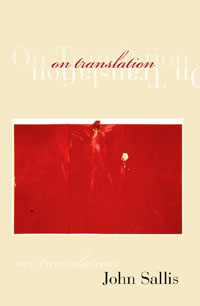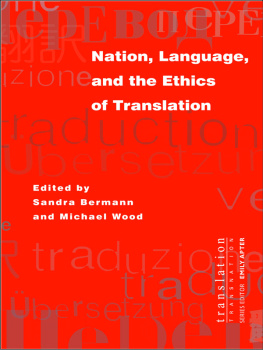Cover

| title | : | On Translation Studies in Continental Thought |
| author | : | Sallis, John. |
| publisher | : | Indiana University Press |
| isbn10 | asin | : | 0253341566 |
| print isbn13 | : | 9780253341563 |
| ebook isbn13 | : | 9780253109446 |
| language | : | English |
| subject | Translating and interpreting--Philosophy, Semantics (Philosophy) |
| publication date | : | 2002 |
| lcc | : | B840.S25 2002eb |
| ddc | : | 107/.2 |
| subject | : | Translating and interpreting--Philosophy, Semantics (Philosophy) |
Page i
On Translation
Page ii
Studies in Continental Thought
J OHN S ALLIS , GENERAL EDITOR
CONSULTING EDITORS |
Robert Bernasconi | William L. McBride |
Rudolph Bernet | J. N. Mohanty |
John D. Caputo | Mary Rawlinson |
David Carr | Tom Rockmore |
Edward S. Casey | Calvin O. Schrag |
Hubert Dreyfus | Reiner Schrmann |
Don Ihde | Charles E. Scott |
David Farrell Krell | Thomas Sheehan |
Lenore Langsdorf | Robert Sokolowski |
Alphonso Lingis | Bruce W. Wilshire |
David Wood |
Page iii
On Translation
JOHN SALLIS

Page iv
This book is a publication of
Indiana University Press
601 North Morton Street
Bloomington, IN 47404-3797 USA
http://iupress.indiana.edu
Telephone orders 800-842-6796
Fax orders 812-855-7931
Orders by e-mail iuporder@indiana.edu
2002 by John Sallis
All rights reserved
No part of this book may be reproduced or utilized in any form or by any means, electronic or mechanical, including photocopying and recording, or by any information storage and retrieval system, without permission in writing from the publisher. The Association of American University Presses' Resolution on Permissions constitutes the only exception to this prohibition.
The paper used in this publication meets the minimum requirements of American National Standard for Information SciencesPermanence of Paper for Printed Library Materials, ANSI Z39.48-1984.
Manufactured in the United States of America
Library of Congress Cataloging-in-Publication Data
Sallis, John, date
On translation / John Sallis.
p. cm. (Studies in Continental thought)
Includes bibliographical references and index.
ISBN 0-253-34156-6 (alk. paper) ISBN 0-253-21553-6 (pbk. : alk. paper)
1. Translating and interpretingPhilosophy. 2. Semantics (Philosophy) I. Title.
II. Series.
B840 .S25 2002
107'.2dc21
2002003001
1 2 3 4 5 07 06 05 04 03 02
Page v
For Charles Scott
In Honor of Friendship
Page vi
This page intentionally left blank.
Page vii
''Bless thee, Bottom, bless thee! Thou art translated."
Page viii
This page intentionally left blank.
Page ix
Contents
Preface | xi |
1. The Dream of Nontranslation | |
2. Scenes of Translation at Large | |
3. Translation and the Force of Words | |
4. Varieties of Untranslatability | |
Index | |
Page x
This page intentionally left blank.
Page xi
Preface
Translation goes astray.
It happens almost inevitably. It happens both with the word, itself a translation, and with the operation (and product) named translation.
Both go, almost inevitably, astray.
To be sure, the word appears stable and its signification well-defined. But nothing could be further from the truth, at least from a certain truth that would consist in coincidence, even in selfsameness. The senses that translation would signify and hold in check prove to multiply, spreading and drifting across an extensive, none-too-stable field. Translation itselfthough in a sense there is no translation itselfgoes likewise astray: gesturing toward the production of sameness (it is called sameness of meaning in the classical determination of translation), it cannot but breach the sameness in the foray that must be made into alterity, for instance, into the alterity of another language. It is as if an ineradicable errancy belonged intrinsically to the very truth of translation.
This text, On Translation, addresses the theme directly. Yet it does so in such a way as to sustain, almost from the beginning, the doubling of this theme back upon its very thematization; there will be indeed multiple respects in which writing on translation becomes a translating of translation. One could say that translation is intrinsically double, since its movement is always across a differential field. In any case, in On Translation, translation becomes a double theme, corresponding to the difference between treating it in its unrestricted spread, as translation at large (Chapter 2), and in its restriction to translation of words (Chapter 3). Treatments of two negative or privative possibilities frame the double treatment of translation: nontranslation, the impossibility of which is almost
Page xii
perpetually countered by a dream (Chapter 1); and untranslatability, which borders on the unspeakable (Chapter 4).
For each of the four themes to which On Translation extends, a kind of topology is put into play. Each is referred to a locus, a place, a site, and is interrogated as it takes shape at that site. What drives the interrogation most forcefully is that each of these places is also, in a certain way, noplace, nowhere: what occurs in a dream is nowhere; just as what occurs in the theatre is nowhere, not even in the theatre where it is played; and just as what one sees in a painting or hears in music is nowhere. To say nothing of words, nothing but words, which will at best only open up the differenceone could call it the difference of all differencesbetween words and the placethe place of all placeswhere everything comes to pass.
My work on the theme of translation goes back to a lecture presented in 1998 at the Collegium Phaenomenologicum at the invitation of Gnter Figal. Subsequently I had opportunities to develop various aspects of this theme in lectures at Trinity College (Connecticut), Tartu University (Estonia), Vassar College, the University of Kansas, and Thammasat University (Bangkok). Some aspects are also developed in a paper, ''Hermeneutik der bersetzung," which appeared in
Next page










